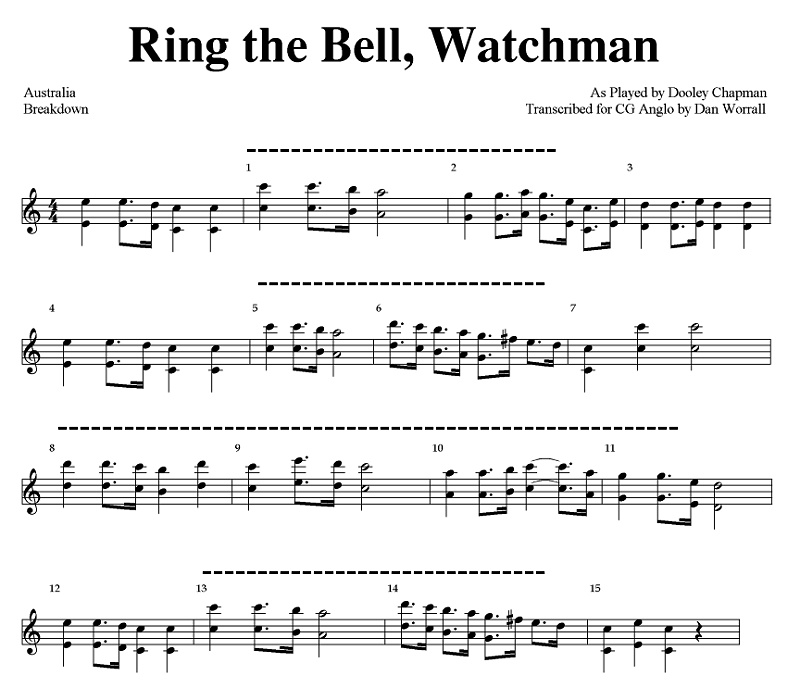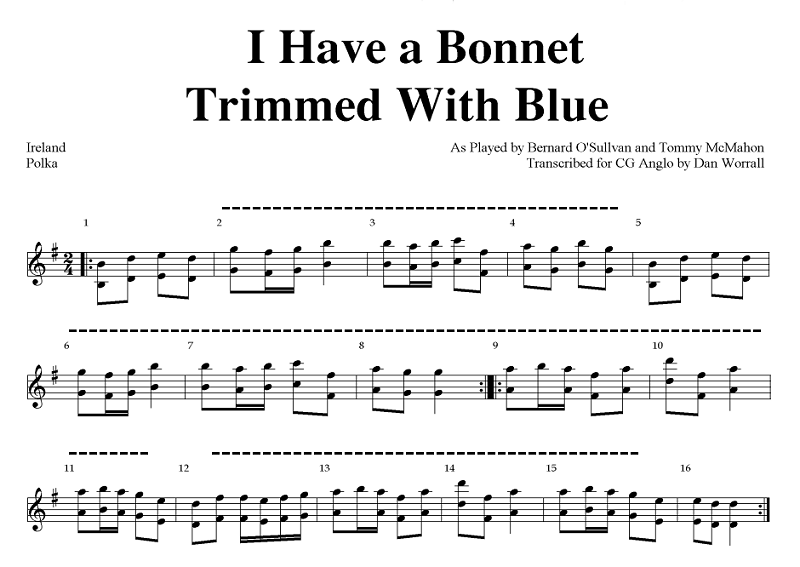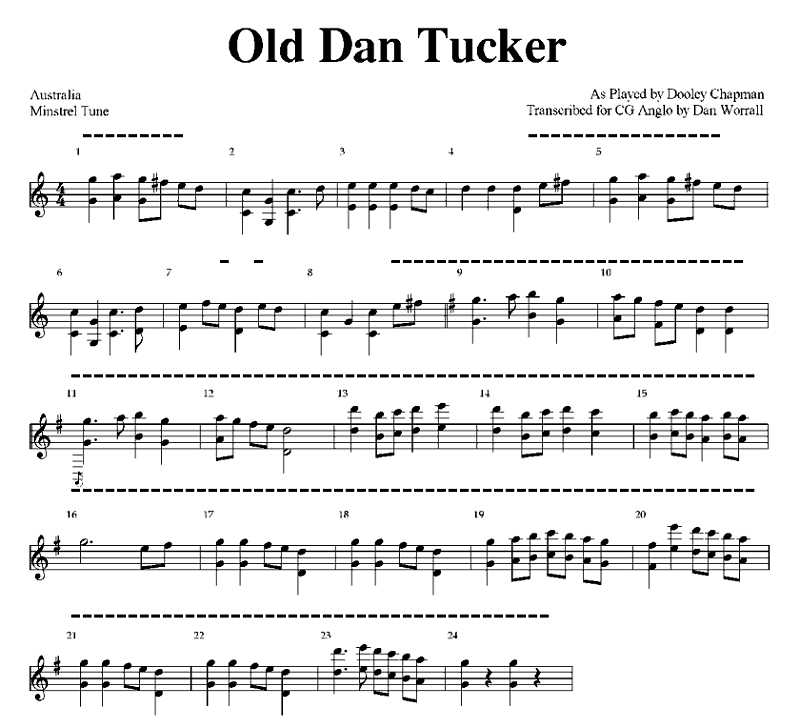Playing in octaves is counter-intuitive, because when moving up a scale, the fingers on the left hand advance from button to button at a different time than the fingers on the right. For that reason, it is a task for muscle memory that must be practiced for some time before it becomes second nature. There is a cross-row transition to be learned as well, which is of course alien to the beginning player, who tends to play - and think - along the row. It is these two skills together that the late Irish concertina and fiddle player John Kelly (1912-1989) referred to when he discussed his early tuition in the instrument, from a woman in his area:

Button numbering convention, three-row Anglo-German concertina. Most early players had only two-row instruments,
which consisted of the bottom two rows shown here. The second (middle) row is in the key of C (buttons 1-5),
and the bottom (inside) row is in the key of G (buttons 6-10).
Please note: the audio examples below are played on two instruments: a 30 button, three row Anglo concertina in the keys of C/G by Colin Dipper in England, and a 20 button, two-row German-style concertina in the keys of C/G by Danie Labuschagne in South Africa. The latter instrument is doubled in octaves, meaning two notes an octave apart play for each single button pushed; this baritone instrument is very similar to those played by Mary Ann Carolan and by Ella Mae O'Dwyer, among others, in the archive recordings. It should be noted that a 20 button two-row instrument is perfectly adequate for the examples and tunes in this tutorial.

The basic two-row octave scale in C. The numbers represent the buttons on the keyboard in the previous figure,
on the right (upper staff) and left (lower), respectively. The two hands play in unison.
P = Press, D = Draw. Buttons are numbered as in Figure 1.

The path of the ascending octave scale in the key of C,
where the fingers trace out a 'double Z' on the buttons.
It will be noted that it is quite easy to continue to play the so-la on the C row rather than moving to the G row, and it is also possible to play the last two notes (ti-do) in octaves on the C row. However, the fingering changes necessary to play the latter two notes on the C row are quite awkward, which is why the two-row octave technique was developed - it is much easier to move down to the G row to play them. So-called single-row octave players will play on the C row for an entire tune, but in that case, either a) the tune does not use a high-end ti-do in its range of notes, b) the musician will simply eliminate the upper octave notes in the high part of the tune, or c) the musician will drop the higher-pitched part of the melody abruptly down an octave. More on this latter option in the example of Scan Tester's playing style, below.
Dooley Chapman's version of the song tune Tutorial 2 goes slowly through the tune with commentary.

Ring the Bell, Watchman as played by Dooley Chapman.
Parts shown with an accompanying dashed line are played on the G row,
and parts without that line are played in the C row.

A two-row octave scale in G, in octaves, for a Jeffries-style two-row concertina.
Bernard O'Sullivan's version of the polka Tutorial 4 goes slowly through the tune with commentary.

Transcription, I Have a Bonnet Trimmed With Blue.
Parts shown with a dashed line are played on the G row,
and parts without that line are played in the C row.
As was mentioned above, when a melody, played in octaves and confined to a single row, reaches either too high or too low for octaves to be comfortably played, one could either drop one octave and continue to play singly, or one could jump the entire melody an octave up or down, and keep sailing through. That is what Tester does in this schottische, which is played entirely on the C row. The following audio file, Tutorial 5, illustrates the process of octave jumps in that tune, with commentary. In the Figure below, the octave jumps are clearly visible in measures 2, 6, 7, 12,and 16.
It should be pointed out that an octave jump such as that in measure 7 is entirely unnecessary, as one could drop down to the G row, in cross-row fashion, and continue to ascend the run of notes without the jump. Tester's other playing show that he indeed could do that, but that was not his choice here; he apparently enjoyed playing an occasional tune full of jumps.

Transcription, Scan Tester's Schottische. It is played entirely on the C row.
The A part of Kimber's version of the Tutorial 6, describes the basic procedure. The A part is played slowly, proceeding from 1) melody played singly on right hand, 2) melody played in octaves throughout, 3) lower octave notes dropped out on second and fourth beats, and 4) partial chords added to remaining left hand octave notes (typically, a third interval up is added to each lower octave note). This basic technique of emphasizing the downbeat by dropping out lower octave notes is essential to nearly all of Kimber's style of playing; it is prominently featured in his schottisches, for example the Moonlight Schottische and Over the Hills to Glory (see Chapter 9).

Transcription for William Kimber's version of Bacca Pipes. The A part (measures 1-16)
is played all on the C row, and the B part is played in a cross-row fashion.
Providing the downbeat in this manner in time with the downward steps of dancers, as Kimber did, was a commonly employed device, but was hardly universal. Some players provided accentuation of the off-beat instead, to provide lift to help the dancers raise their feet. There are likely multiple origins for off-the-beat playing, where the second and fourth beats, rather than the first and third, get the emphasis. However, American minstrel music picked up off-beat emphasis from African-American musicians and popularized it around the globe during the middle to late nineteenth century. In particular, the African banjo was principally strummed on the off-beat, and was the key instrument for the minstrel genre. Period writings in England describe the fascination of people when they heard these 'wild' and intoxicating rhythms for the first time.
The playing of Irishwoman Mary Ann Carolan provides an example of such lift. Mrs Carolan was no stranger to minstrel music; one of her traditional songs, Young Bob Ridley, originated in American minstrel shows in the middle of the nineteenth century. In the middle of the A part of her version of the polka Tutorial 7, the tune is dissected slowly, with commentary. The tune is played entirely on the C row, and largely in octaves.
Her version is at a sprightly tempo and is fairly easy to play on a modern Anglo concertina. One should recall however that she plays it on a German concertina, which demands a great deal more energy and strength in order to pump its bellows that rapidly. One is reminded of the late Texas Governor Ann Richard's description of the actress and dancer Ginger Rogers: "Ginger did everything Fred Astaire did, only backwards and in high heels."
Another example of off-beat emphasis is provided by the tune Getting Upstairs also has an off-beat pulse, in a tune that was originally an American minstrel show breakdown.

Two musicians with fretless banjos with Anglo concertina player, Australia, ca.1870.
Fretless banjos entered Australia and elsewhere by way of the minstrel shows,
and had a large impact upon repertoire and musical rhythm amongst amateur musicians.
Photo courtesy Peter Cuffley and Peter Ellis.
Note how South African musician Faan Harris employs a left hand beat in the A part of his Soutpansberg Settees, as in the attached transcription, below. Although he provides octave notes on both the beat and off-beat, it is the off-beat that gets most of the emphasis.

Chapman's version of Tutorial 9, the tune is played slowly and with commentary on how the F# was inserted; it is a side-effect of playing in octaves in a cross-row manner. It is not a modification that is necessary to the music, as it is just as easy to play the normal F; clearly these musicians liked the sound of the F#. Australian players like Con Klippel and Fred Holland, who typically stuck to single-row playing, did not employ this modification.
In the tutorial, I played measure 7 all on the C row and all in octaves, giving it a bounce. Dooley however preferred a more subtle legato phrasing here, precisely as written. The octaves are dropped, and the two phrases in that measure are played mostly singly and across the rows, which takes out two bellows direction changes.

With these few lessons and a little practice, any Anglo player should be able to master the old art of octave-style playing. Its emphasis is on simplicity for dancing, rather than showy musical virtuosity, and it was this fit-for-purpose simplicity that made it so universal a technique in so many varied settings around the globe. When learning by ear from the archived recordings of early musicians, it helps to utilize slow-down software. With appropriate software (like Roni Music's The Amazing Slow-Downer), one can not only slow the tempo down, but change the pitch. For example, recordings of players using Bb/F concertinas can be brought into compliance with a concertina in C/G pitch simply by raising the pitch one semitone. In addition, pitch variance caused by primitive tape recorders used in field recordings can be cured by adjusting the pitch more finely, in cents.
In the final analysis, traditional styles of concertina playing can survive only in the presence of dancing, and most especially the old time round dances and quadrilles, for which the concertina's classic repertoire was created. Playing this old music well may require that one finds a house dance or community dance to listen to, dance for, and finally play for.
| NEXT |